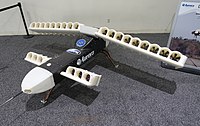
Photo from wikipedia
The scope of the present paper is to assess the potential of distributed propulsion for a regional aircraft regarding aero-propulsive efficiency. Several sensitivities such as the effect of wingtip propellers,… Click to show full abstract
The scope of the present paper is to assess the potential of distributed propulsion for a regional aircraft regarding aero-propulsive efficiency. Several sensitivities such as the effect of wingtip propellers, thrust distribution, and shape modifications are investigated based on a configuration with 12 propulsors. Furthermore, an initial assessment of the high-lift performance is undertaken in order to estimate potential wing sizing effects. The performance of the main wing and the propellers are thereby equally considered with the required power being the overall performance indicator. The results indicate that distributed propulsion is not necessarily beneficial regarding the aero-propulsive efficiency in cruise flight. However, the use of wing tip propellers, optimization of the thrust distribution, and wing resizing effects lead to a reduction in required propulsive power by $$-2.9$$ - 2.9 to $$-3.3\,\%$$ - 3.3 % compared to a configuration with two propulsors. Adapting the leading edge to the local flow conditions did not show any substantial improvement in cruise configuration to date.
Journal Title: CEAS Aeronautical Journal
Year Published: 2021
Link to full text (if available)
Share on Social Media: Sign Up to like & get
recommendations!